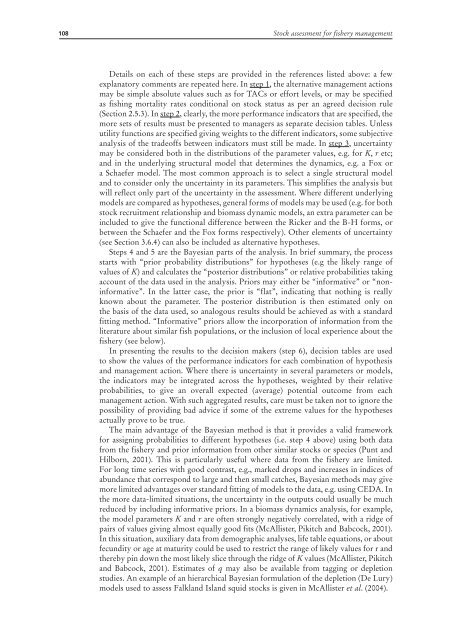Stock assessment for fishery management - Library
Stock assessment for fishery management - Library
Stock assessment for fishery management - Library
Create successful ePaper yourself
Turn your PDF publications into a flip-book with our unique Google optimized e-Paper software.
108 <strong>Stock</strong> <strong>assessment</strong> <strong>for</strong> <strong>fishery</strong> <strong>management</strong>Details on each of these steps are provided in the references listed above: a fewexplanatory comments are repeated here. In step 1, the alternative <strong>management</strong> actionsmay be simple absolute values such as <strong>for</strong> TACs or ef<strong>for</strong>t levels, or may be specifiedas fishing mortality rates conditional on stock status as per an agreed decision rule(Section 2.5.3). In step 2, clearly, the more per<strong>for</strong>mance indicators that are specified, themore sets of results must be presented to managers as separate decision tables. Unlessutility functions are specified giving weights to the different indicators, some subjectiveanalysis of the tradeoffs between indicators must still be made. In step 3, uncertaintymay be considered both in the distributions of the parameter values, e.g. <strong>for</strong> K, r etc;and in the underlying structural model that determines the dynamics, e.g. a Fox ora Schaefer model. The most common approach is to select a single structural modeland to consider only the uncertainty in its parameters. This simplifies the analysis butwill reflect only part of the uncertainty in the <strong>assessment</strong>. Where different underlyingmodels are compared as hypotheses, general <strong>for</strong>ms of models may be used (e.g. <strong>for</strong> bothstock recruitment relationship and biomass dynamic models, an extra parameter can beincluded to give the functional difference between the Ricker and the B-H <strong>for</strong>ms, orbetween the Schaefer and the Fox <strong>for</strong>ms respectively). Other elements of uncertainty(see Section 3.6.4) can also be included as alternative hypotheses.Steps 4 and 5 are the Bayesian parts of the analysis. In brief summary, the processstarts with “prior probability distributions” <strong>for</strong> hypotheses (e.g the likely range ofvalues of K) and calculates the “posterior distributions” or relative probabilities takingaccount of the data used in the analysis. Priors may either be “in<strong>for</strong>mative” or “nonin<strong>for</strong>mative”.In the latter case, the prior is “flat”, indicating that nothing is reallyknown about the parameter. The posterior distribution is then estimated only onthe basis of the data used, so analogous results should be achieved as with a standardfitting method. “In<strong>for</strong>mative” priors allow the incorporation of in<strong>for</strong>mation from theliterature about similar fish populations, or the inclusion of local experience about the<strong>fishery</strong> (see below).In presenting the results to the decision makers (step 6), decision tables are usedto show the values of the per<strong>for</strong>mance indicators <strong>for</strong> each combination of hypothesisand <strong>management</strong> action. Where there is uncertainty in several parameters or models,the indicators may be integrated across the hypotheses, weighted by their relativeprobabilities, to give an overall expected (average) potential outcome from each<strong>management</strong> action. With such aggregated results, care must be taken not to ignore thepossibility of providing bad advice if some of the extreme values <strong>for</strong> the hypothesesactually prove to be true.The main advantage of the Bayesian method is that it provides a valid framework<strong>for</strong> assigning probabilities to different hypotheses (i.e. step 4 above) using both datafrom the <strong>fishery</strong> and prior in<strong>for</strong>mation from other similar stocks or species (Punt andHilborn, 2001). This is particularly useful where data from the <strong>fishery</strong> are limited.For long time series with good contrast, e.g., marked drops and increases in indices ofabundance that correspond to large and then small catches, Bayesian methods may givemore limited advantages over standard fitting of models to the data, e.g. using CEDA. Inthe more data-limited situations, the uncertainty in the outputs could usually be muchreduced by including in<strong>for</strong>mative priors. In a biomass dynamics analysis, <strong>for</strong> example,the model parameters K and r are often strongly negatively correlated, with a ridge ofpairs of values giving almost equally good fits (McAllister, Pikitch and Babcock, 2001).In this situation, auxiliary data from demographic analyses, life table equations, or aboutfecundity or age at maturity could be used to restrict the range of likely values <strong>for</strong> r andthereby pin down the most likely slice through the ridge of K values (McAllister, Pikitchand Babcock, 2001). Estimates of q may also be available from tagging or depletionstudies. An example of an hierarchical Bayesian <strong>for</strong>mulation of the depletion (De Lury)models used to assess Falkland Island squid stocks is given in McAllister et al. (2004).
















